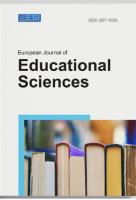The Evolution of Students' Mental Models and Metaphors towards the Atomic Concept*
The Evolution of Students' Mental Models and Metaphors towards the Atomic Concept*
Author(s): Halit KiriktaşSubject(s): Social Sciences, Education
Published by: European Scientific Institute
Keywords: Curriculum; geometric shapes; mathematics; preschool
Summary/Abstract: This study examined the effect of the Building Blocks mathematical education program on 4-year-old Turkish preschool children’s recognition level of geometrical shapes. A pretest-posttest control group experimental design was employed. The sample group was composed of randomly selected 39 preschool children (of whom 21 were in the experimental group, and 18 in the control group). A geometric shapes recognition test was used for data collection. Results indicated meaningful differences in the mean scores of the triangle and rectangle shapes in favor of the experimental group. When the children’s responses to the geometric shapes recognition test were examined in detail, it was observed that in the post-test the children in the experimental group, as compared to the ones in the control group, were more inclined to define geometrical shapes with their qualitative features rather than visual features.It could be argued that the main goal of the teaching process is to create accurate projections of scientific models in the minds of individuals. In this context, it could be argued that it is important to determine the change and development of the mental models that individuals create for events/phenomena and related metaphors in this process.This paper seeks to reveal how the mental models and metaphors of students with similar sociodemographic characteristics have evolved throughout the teaching process from secondary school to the undergraduate level. In the present study, the cross-sectional survey model, which is one of the descriptive research methods, was used. While the population of the study consists of students and pre-service teachers who receive formal education in public schools located in the South East Anatolia region in the 2019-2020 academic year, the sample consists of 720 students in total selected in equal numbers from every grade level with similar socio-demographic characteristics (60 students selected from the 5th-grade to the 4th-year students of the undergraduate degree). The data collection tool used in the study was a four-tier conceptual understanding testcreated by the researcher, who also tested its validity and reliability. The data were subjected to descriptive statistics, content analysis, and the Chi-square test.The results reveal that the students have highly different definitions and metaphors for the concept of the atom with their mental models generally evolving up to the Rutherford atomic model and failing to reach a higher model.It is recommended in future studies that researchers follow the process longitudinally and investigate the reasons why students' mental models fail to evolve into higher atomic models.
Journal: European Journal of Educational Sciences
- Issue Year: 10/2023
- Issue No: 1
- Page Range: 69-83
- Page Count: 14
- Language: English

